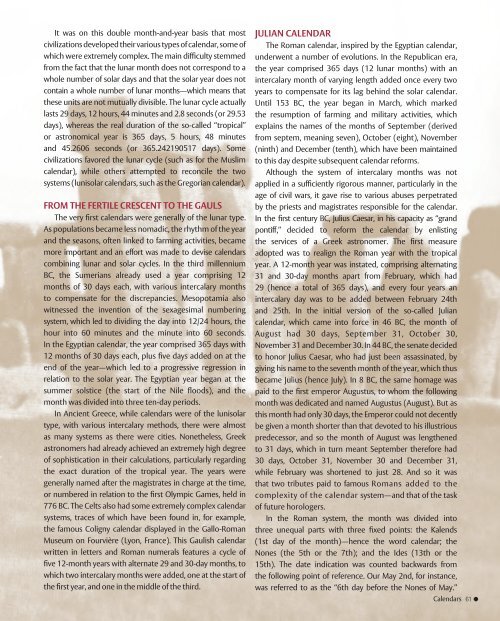Letter from the Publisher
Letter from the Publisher
Letter from the Publisher
You also want an ePaper? Increase the reach of your titles
YUMPU automatically turns print PDFs into web optimized ePapers that Google loves.
It was on this double month-and-year basis that most<br />
civilizations developed <strong>the</strong>ir various types of calendar, some of<br />
which were extremely complex. The main difficulty stemmed<br />
<strong>from</strong> <strong>the</strong> fact that <strong>the</strong> lunar month does not correspond to a<br />
whole number of solar days and that <strong>the</strong> solar year does not<br />
contain a whole number of lunar months—which means that<br />
<strong>the</strong>se units are not mutually divisible. The lunar cycle actually<br />
lasts 29 days, 12 hours, 44 minutes and 2.8 seconds (or 29.53<br />
days), whereas <strong>the</strong> real duration of <strong>the</strong> so-called “tropical”<br />
or astronomical year is 365 days, 5 hours, 48 minutes<br />
and 45.2606 seconds (or 365.242190517 days). Some<br />
civilizations favored <strong>the</strong> lunar cycle (such as for <strong>the</strong> Muslim<br />
calendar), while o<strong>the</strong>rs attempted to reconcile <strong>the</strong> two<br />
systems (lunisolar calendars, such as <strong>the</strong> Gregorian calendar).<br />
From The FerTile CresCenT To The Gauls<br />
The very first calendars were generally of <strong>the</strong> lunar type.<br />
as populations became less nomadic, <strong>the</strong> rhythm of <strong>the</strong> year<br />
and <strong>the</strong> seasons, often linked to farming activities, became<br />
more important and an effort was made to devise calendars<br />
combining lunar and solar cycles. In <strong>the</strong> third millennium<br />
BC, <strong>the</strong> Sumerians already used a year comprising 12<br />
months of 30 days each, with various intercalary months<br />
to compensate for <strong>the</strong> discrepancies. Mesopotamia also<br />
witnessed <strong>the</strong> invention of <strong>the</strong> sexagesimal numbering<br />
system, which led to dividing <strong>the</strong> day into 12/24 hours, <strong>the</strong><br />
hour into 60 minutes and <strong>the</strong> minute into 60 seconds.<br />
In <strong>the</strong> egyptian calendar, <strong>the</strong> year comprised 365 days with<br />
12 months of 30 days each, plus five days added on at <strong>the</strong><br />
end of <strong>the</strong> year—which led to a progressive regression in<br />
relation to <strong>the</strong> solar year. The egyptian year began at <strong>the</strong><br />
summer solstice (<strong>the</strong> start of <strong>the</strong> nile floods), and <strong>the</strong><br />
month was divided into three ten-day periods.<br />
In ancient Greece, while calendars were of <strong>the</strong> lunisolar<br />
type, with various intercalary methods, <strong>the</strong>re were almost<br />
as many systems as <strong>the</strong>re were cities. none<strong>the</strong>less, Greek<br />
astronomers had already achieved an extremely high degree<br />
of sophistication in <strong>the</strong>ir calculations, particularly regarding<br />
<strong>the</strong> exact duration of <strong>the</strong> tropical year. The years were<br />
generally named after <strong>the</strong> magistrates in charge at <strong>the</strong> time,<br />
or numbered in relation to <strong>the</strong> first Olympic Games, held in<br />
776 BC. The Celts also had some extremely complex calendar<br />
systems, traces of which have been found in, for example,<br />
<strong>the</strong> famous Coligny calendar displayed in <strong>the</strong> Gallo-roman<br />
Museum on Fourvière (lyon, France). This Gaulish calendar<br />
written in letters and roman numerals features a cycle of<br />
five 12-month years with alternate 29 and 30-day months, to<br />
which two intercalary months were added, one at <strong>the</strong> start of<br />
<strong>the</strong> first year, and one in <strong>the</strong> middle of <strong>the</strong> third.<br />
Julian Calendar<br />
The roman calendar, inspired by <strong>the</strong> egyptian calendar,<br />
underwent a number of evolutions. In <strong>the</strong> republican era,<br />
<strong>the</strong> year comprised 365 days (12 lunar months) with an<br />
intercalary month of varying length added once every two<br />
years to compensate for its lag behind <strong>the</strong> solar calendar.<br />
until 153 BC, <strong>the</strong> year began in March, which marked<br />
<strong>the</strong> resumption of farming and military activities, which<br />
explains <strong>the</strong> names of <strong>the</strong> months of September (derived<br />
<strong>from</strong> septem, meaning seven), October (eight), november<br />
(ninth) and december (tenth), which have been maintained<br />
to this day despite subsequent calendar reforms.<br />
although <strong>the</strong> system of intercalary months was not<br />
applied in a sufficiently rigorous manner, particularly in <strong>the</strong><br />
age of civil wars, it gave rise to various abuses perpetrated<br />
by <strong>the</strong> priests and magistrates responsible for <strong>the</strong> calendar.<br />
In <strong>the</strong> first century BC, Julius Caesar, in his capacity as “grand<br />
pontiff,” decided to reform <strong>the</strong> calendar by enlisting<br />
<strong>the</strong> services of a Greek astronomer. The first measure<br />
adopted was to realign <strong>the</strong> roman year with <strong>the</strong> tropical<br />
year. a 12-month year was instated, comprising alternating<br />
31 and 30-day months apart <strong>from</strong> February, which had<br />
29 (hence a total of 365 days), and every four years an<br />
intercalary day was to be added between February 24th<br />
and 25th. In <strong>the</strong> initial version of <strong>the</strong> so-called Julian<br />
calendar, which came into force in 46 BC, <strong>the</strong> month of<br />
august had 30 days, September 31, October 30,<br />
november 31 and december 30. In 44 BC, <strong>the</strong> senate decided<br />
to honor Julius Caesar, who had just been assassinated, by<br />
giving his name to <strong>the</strong> seventh month of <strong>the</strong> year, which thus<br />
became Julius (hence July). In 8 BC, <strong>the</strong> same homage was<br />
paid to <strong>the</strong> first emperor augustus, to whom <strong>the</strong> following<br />
month was dedicated and named augustus (august). But as<br />
this month had only 30 days, <strong>the</strong> emperor could not decently<br />
be given a month shorter than that devoted to his illustrious<br />
predecessor, and so <strong>the</strong> month of august was leng<strong>the</strong>ned<br />
to 31 days, which in turn meant September <strong>the</strong>refore had<br />
30 days, October 31, november 30 and december 31,<br />
while February was shortened to just 28. and so it was<br />
that two tributes paid to famous romans added to <strong>the</strong><br />
complexity of <strong>the</strong> calendar system—and that of <strong>the</strong> task<br />
of future horologers.<br />
In <strong>the</strong> roman system, <strong>the</strong> month was divided into<br />
three unequal parts with three fixed points: <strong>the</strong> Kalends<br />
(1st day of <strong>the</strong> month)—hence <strong>the</strong> word calendar; <strong>the</strong><br />
nones (<strong>the</strong> 5th or <strong>the</strong> 7th); and <strong>the</strong> Ides (13th or <strong>the</strong><br />
15th). The date indication was counted backwards <strong>from</strong><br />
<strong>the</strong> following point of reference. Our May 2nd, for instance,<br />
was referred to as <strong>the</strong> “6th day before <strong>the</strong> nones of May.”<br />
Calendars 61 •
















